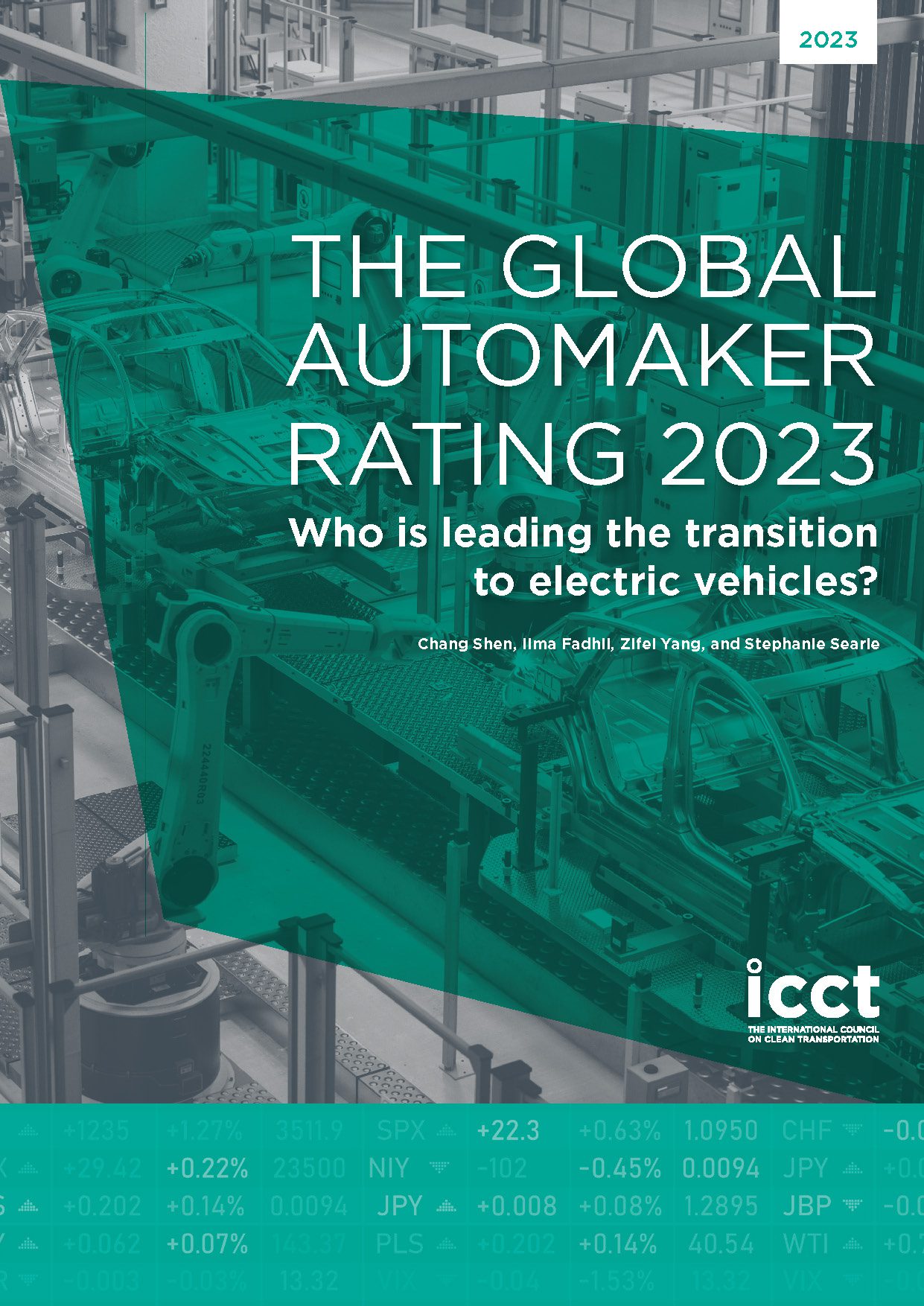Global Automaker Rating 2023
Who is leading the transition to electric vehicles?
This report assesses how the world’s largest automakers stack up in the transition to ZEVs—that is, battery electric vehicles (BEVs) and fuel-cell electric vehicles (FCEVs). Focused on the top 21 light-duty vehicle manufacturers in the world by sales in 2023, we use the same 10 custom-built metrics as in the 2022 report to reflect automakers’ efforts and strategies in transitioning their vehicle fleets to zero tailpipe emissions and decarbonizing production processes.
AT A GLANCE
• Tesla and BYD were still leading the pack in 2023. However, to maintain that edge as the EV market matures, BYD will need to shift away from PHEV sales which are currently at 48%, and both OEMs will need to expand their class coverage.
• Mercedes-Benz, SAIC, and Chang’an are the most improved manufacturers in the rating compared with 2022. Mercedes-Benz is one of the most improved in decarbonizing its supply chain with increased use of renewable energy and deployment of battery recycling and repurposing. The other was Chang’an, which announced new battery recycling and reuse efforts. SAIC has the largest growth in its ZEV sales share.
• Automakers based in Japan and India are still at the bottom of our rating, but Tata Motors is a rising star. Tata Motors increased its ZEV target ambition and investment, along with significant technology improvements.
While the global zero-emission vehicle (ZEV) market made significant strides in 2023, the performance of individual automakers varied compared with their 2022 scores.
Focused on the top 21 light-duty vehicle manufacturers in the world by sales in 2023, we use the same 10 custom-built metrics as in the 2022 report to reflect automakers’ efforts and strategies in transitioning their vehicle fleets to zero tailpipe emissions and decarbonizing production processes. We refined the evaluation methodologies of selected metrics to better capture the year-on-year movement across manufacturers. Nevertheless, the consistency in our evaluation framework enables us to track automakers’ progress from 2022 to 2023. Figure ES1 compares our 2022 ratings (numerical scores) with our 2023 findings.
From 2022 to 2023, the numerical scores of seven automakers increased, 12 decreased, and one stayed the same. As ratings are based on relative performance among automakers, a decrease could either mean a manufacturer’s performance regressed or the performance of competitors improved. Overall, the global ZEV market advanced substantially in 2023 with growing sales, improved technology performance, and more ambitious visions.

METRICS
Across the 10 metrics analyzed in the report, there were six metrics on which most automakers improved in 2023 compared with 2022, one metric on which many scores worsened, and three metrics with little change.
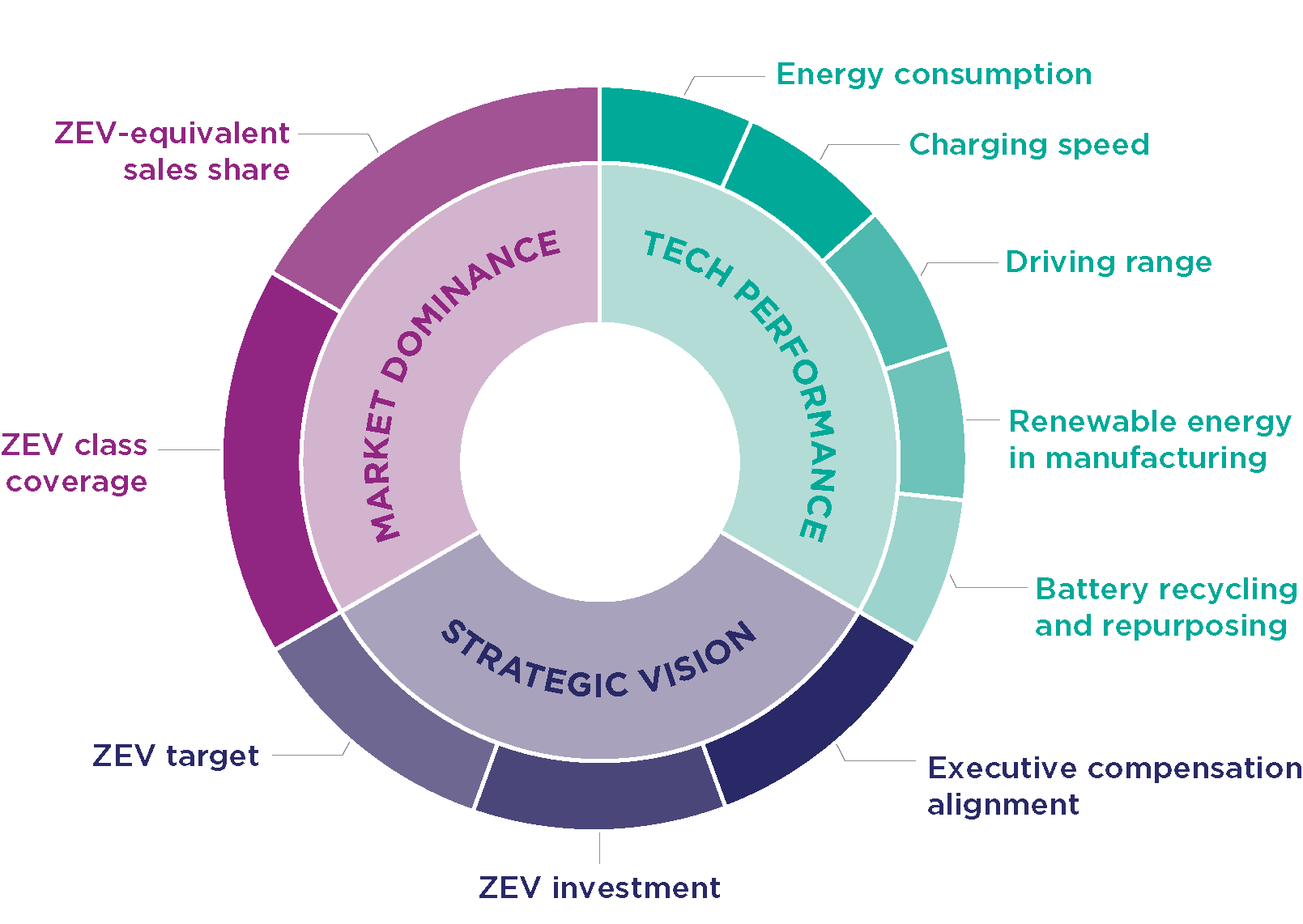
- ZEV-equivalent sales share
- Class coverage
- Energy consumption
- Charging speed
- Driving range
- Renewable energy in manufacturing
- Battery recycling and repurposing
- ZEV targets
- ZEV investment
- Executive compensation alignment
Fifteen automakers increased their ZEV-equivalent sales share in 2023. The overall ZEV-equivalent sales share of the top automakers in the six markets grew from 11% in 2022 to 15% in 2023. China-based automakers made up six of the top 10 performers, with ZEV-equivalent sales shares of 17%–76% in 2023. SAIC reached 40% sales share in 2023, following Tesla (100%) and BYD (76%). German-based manufacturers BMW and Mercedes-Benz grew their ZEV-equivalent sales by 5 percentage points each. Only Hyundai-Kia and Renault had a decline in ZEV-equivalent sales shares across the six major markets.

Nine automakers reduced their class coverage. Seven (Geely, Chang’an, VW, Hyundai-Kia, Nissan, Great Wall, and Honda) discontinued the production of BEVs or FCEVs in certain classes. In addition, two manufacturers (Great Wall and BYD) recorded dwindling sales of some of ZEV models, which may indicate a coming decision to discontinue them. For our 2023 rating, a methodological change to give automakers credit for offering a vehicle class only in the markets where more than 1,000 of those vehicles were sold led to a decline in scores for several automakers. Although we recalculated our benchmark to reflect this change, 14 automakers saw a score decrease from 2022 to 2023 for this metric.
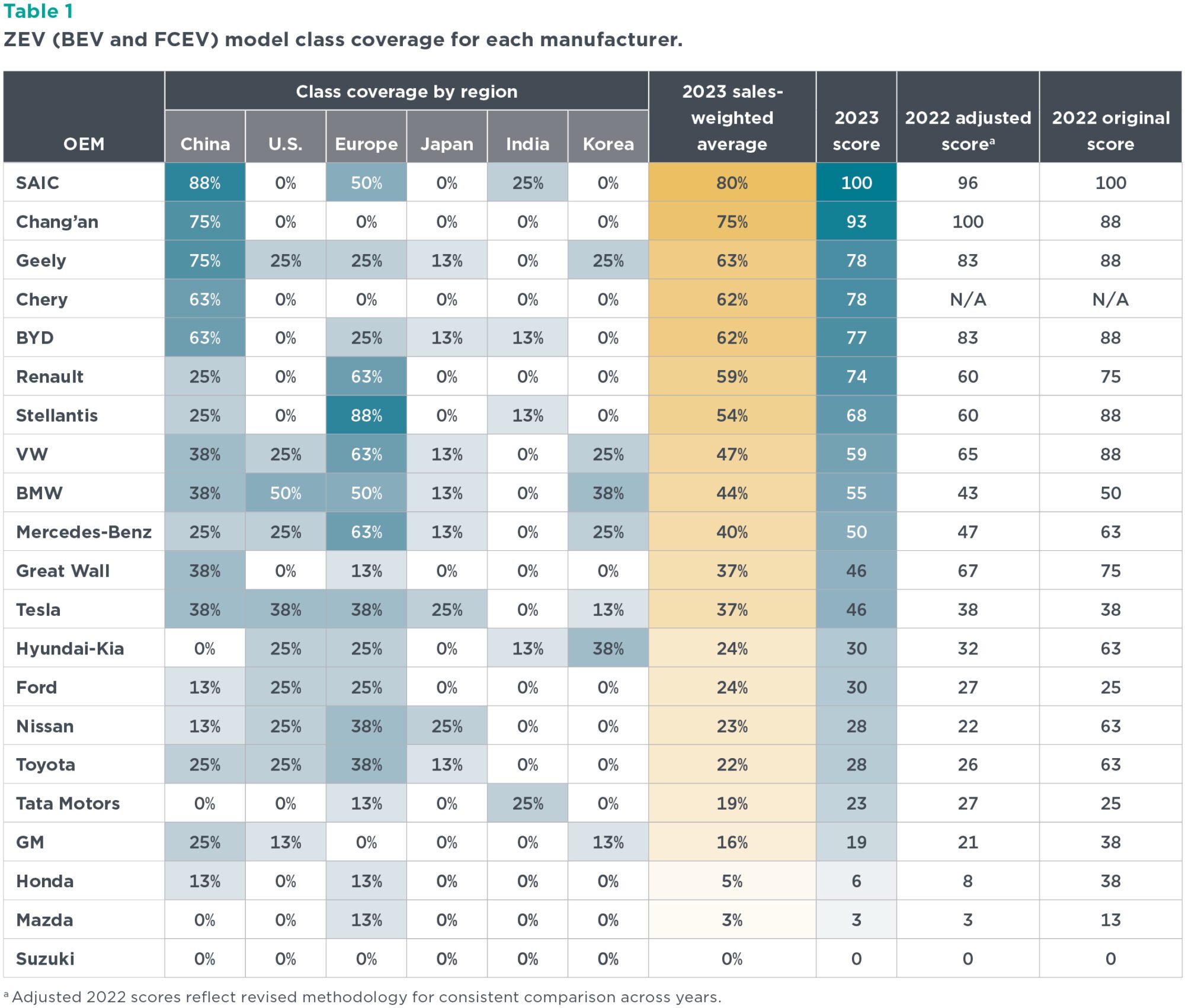
Eleven automakers improved the average efficiency of BEVs sold, although only seven saw a score increase because of the higher benchmark set in 2023. Tata Motors bumped Tesla out of the top spot with a fleet-average energy consumption of 84 kW/km (114 kW/km after the weight adjustment). On average, the energy consumption of BEVs across top automakers declined from 140 Wh/km in 2022 to 135 Wh/km in 2023.
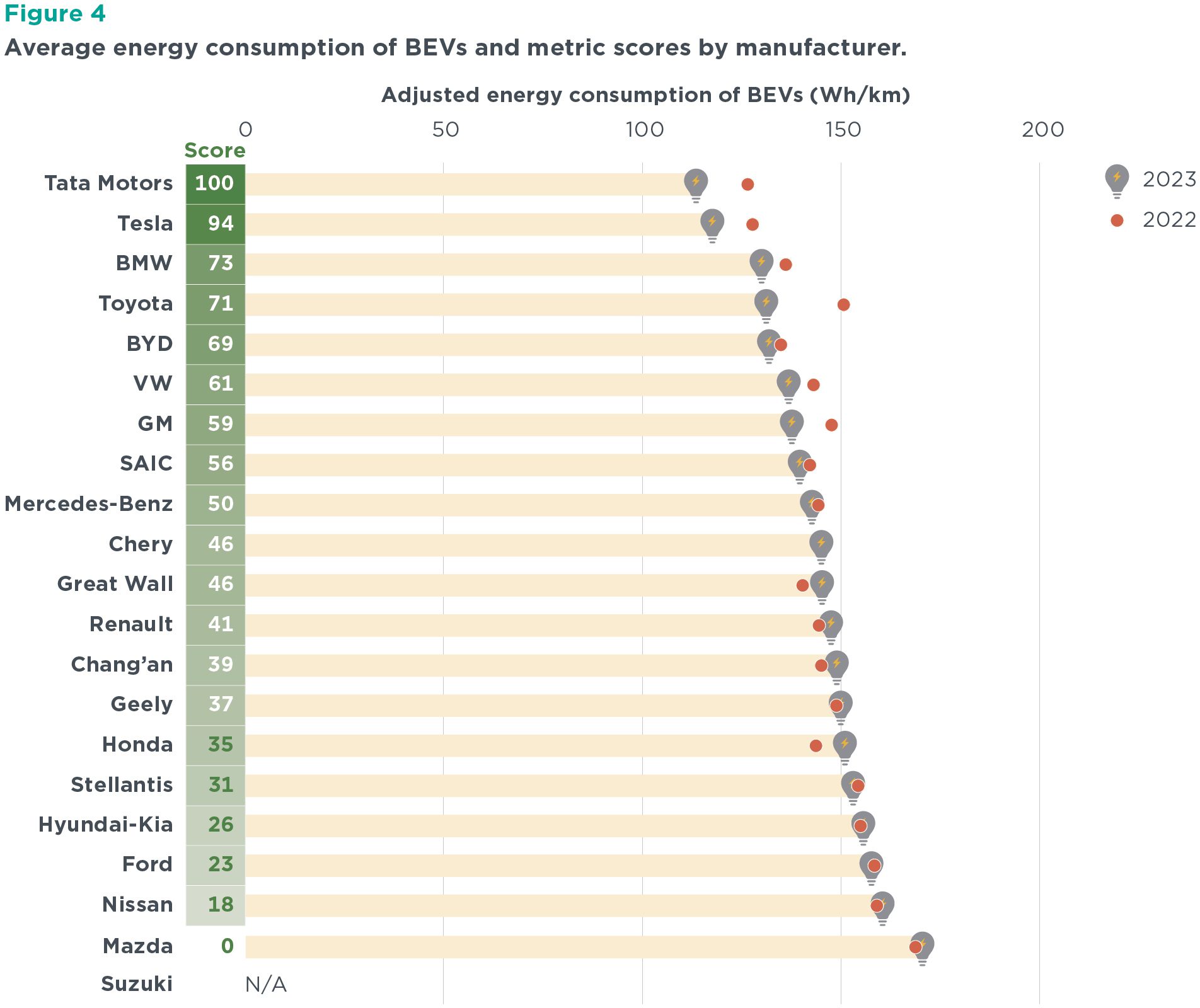
Overall, most automakers had no notable change in average charging speeds across their BEV models.

Fourteen automakers increased the average driving range of their BEVs, an attribute important to consumers. Five (SAIC, Great Wall, BMW, Tata Motors, and Toyota) saw increases of more than 50 km. On average, the driving range of BEVs across top automakers increased from 395 km in 2022 to 419 km in 2023.

Only Mercedes-Benz made big progress in using renewable electricity for vehicle and battery manufacturing, by requiring battery suppliers to be carbon neutral with an emphasis on using 100% renewable energy. Besides Mercedes-Benz, BMW and VW continued to lead on this metric. All other automakers need to take big actions to decarbonize their manufacturing processes.

Most manufacturers announced battery recycling and reusing projects in their major markets, with two automakers (VW and Mercedes- Benz) expanding their efforts in battery recycling and repurposing across multiple markets. Chang’an announced a battery recycling project in its home market, China. We noticed that some announced projects showed no evidence of implementation and, in the future, will consider differentiating between projects that are being implemented from those that are still in the planning stage.
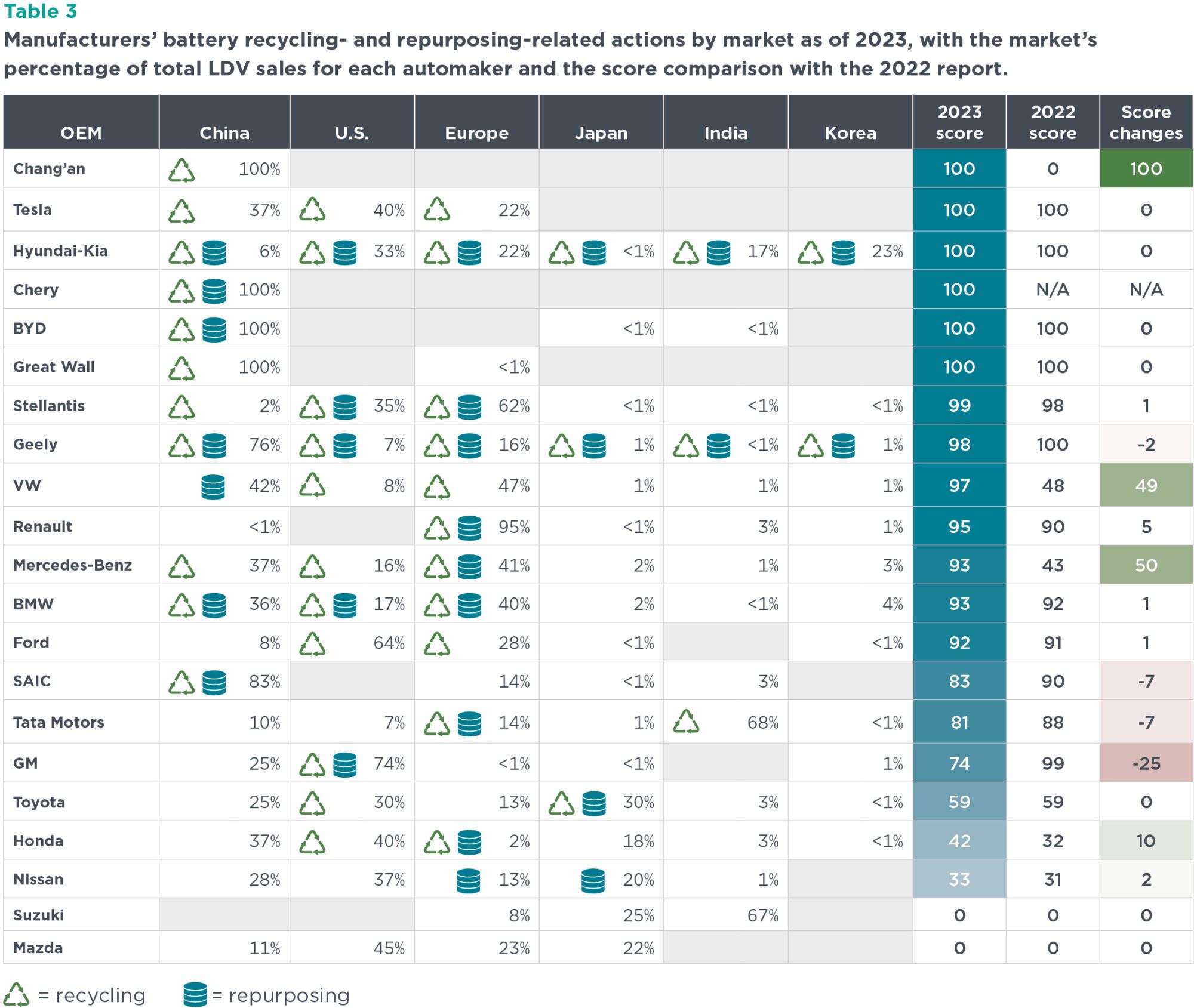
Seven automakers showed a stronger commitment to the transition by increasing their ZEV targets in 2023. Five of them (Geely, SAIC, VW, Hyundai-Kia, and Tata Motors) increased targets for at least some of their brands by 5–20 percentage points. Suzuki announced its first-ever ZEV target, while BMW moved its 100% ZEV target for MINI from early 2030s to a clearly indicated year of 2031.

Thirteen automakers increased their ZEV investment per vehicle. Tesla still leads in investment with $3,740 per vehicle. Other automakers that substantially bumped up ZEV investment are SAIC ($2,427), Geely ($1,677), Mercedes- Benz ($1,567), and Tata Motors ($756). Nevertheless, only some automakers saw a rating increase after benchmarking with Tesla’s increased performance on this metric.

Automakers are making noticeable progress in incentivizing their executives to meet EV or CO2 targets. Stellantis, BMW, and GM more heavily considered EVs in their executive compensation packages in 2023 compared to 2022. Ford and Mercedes-Benz linked executive compensation to EVs for the first time, while Volvo (owned by Geely) and JLR (owned by Tata Motors) added a CO2 emission element to their compensation rubrics.

Notable trends
Some notable trends across manufacturers from 2022 to 2023:
- Most automakers improved their performance across six metrics: ZEV sales shares, energy consumption, driving range, ZEV target, ZEV investment, and executive compensation. Because the top performers set new benchmarks for some metrics, not all automakers that improved their performance saw a score increase for a given metric.
- Fifteen automakers increased their ZEV-equivalent sales share, which increased to 14.6% on average across all automakers, up from 11.2% in 2022. China-based automakers (BYD, SAIC, Geely, Chang’an, Great Wall, and Chery) had some of the highest ZEV-equivalent sales shares.
- Eleven automakers made their BEVs more efficient by reducing average energy consumption. Of these, however, only seven saw a score increase relative to their competition because Tata Motors set a new benchmark, bumping Tesla out of the top spot.
- Fourteen automakers increased the average driving range of their BEVs, an important performance metric for consumers; five of them (SAIC, Great Wall, BMW, Tata Motors, and Toyota) increased by more than 50 km. Across all the manufacturers, the average BEV driving range increased from 395 km in 2022 to 419 km in 2023.
- Seven automakers publicly increased their ZEV targets. Five of them (Geely, SAIC, VW, Hyundai-Kia, and Tata Motors) increased targets for at least some of their brands by 5–20 percentage points. Suzuki announced its first ever ZEV target, while BMW moved its 100% ZEV target for MINI from the early 2030s to a clearly indicated target year of 2031.
- Thirteen automakers were investing more in the ZEV transition compared with the 2022 rating. Tesla still led in investment with $3,740 per vehicle. Meanwhile, seven automakers either introduced or strengthened linkages between top executives’ compensation packages and ZEVs or vehicle CO2.
- Automakers continued to struggle with ZEV class coverage. Overall, total ZEV model offerings increased by between 10% and 42% across the six markets surveyed. But that trend is was uneven across automakers in terms of the variety of ZEV models offered: seven manufacturers discontinued certain ZEV models, resulting in no ZEV option in corresponding segments in 2023.
- For our 2023 rating, we made a change to our class coverage assessment to give automakers credit for offering vehicle classes only in markets in which more than 1,000 of those vehicles were sold. This led to a decline in scores for several automakers. Some automakers faced score declines because they only sold some ZEV models in selected markets, while others saw dwindling sales of vehicle models that have since been discontinued.
Kelli Pennington, Global Communications Manager, and Zifei Yang, Program Lead, ICCT
communications@theicct.org
DISCLAIMER
This ICCT report is intended for informational purposes only. Although the ICCT has endeavored to organize and present data from multiple third-party sources in an even-handed and neutral fashion, the selection, interpretation, weighting, and presentation of the metrics in this rating reflect the subjective assessments and opinions of the ICCT. Additionally, while the ICCT has only used data sources it believes to be reliable, taken steps to verify such data with automakers, and identified its sources in the interest of transparency and verification, it cannot state that the data compiled and published by others is accurate. This report should not be construed otherwise.

